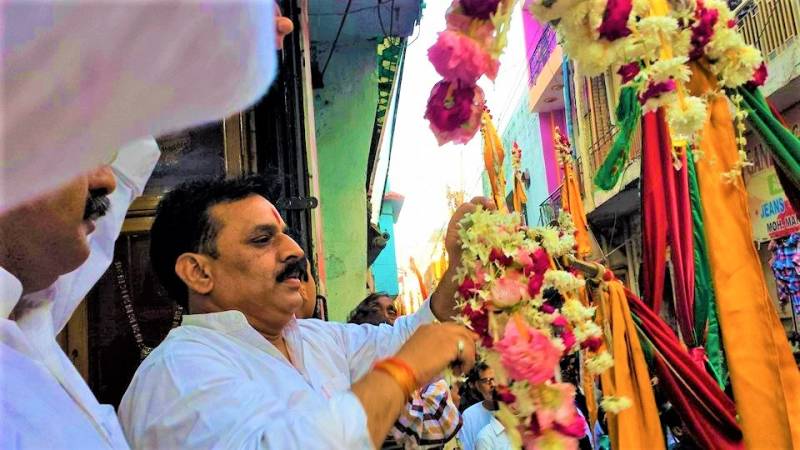
The Subcontinent has a long and rich history of mourning for Imam Hussain (AS) and the martyrs of Karbala. The Imam was not ready to give his allegiance to Yazid and during the negotiations with Yazid’s emissaries, the option of the Imam leaving the Umayyad Empire and going to India was mentioned. Imam Husain ultimately chose martyrdom on the burning sand of Karbala but prior to final battle on 10th Muharram 680 AD, Imam Husain’s son Zain-ul-Abedin, the fourth Shia Imam, sent a letter to his aunt’s family in India telling them about their impending confrontation with the forces of evil.
According to traditions, Zain-ul-Abedin’s mother, Bibi Shahar Bano, was the daughter of the last Sasanian king, Yazdegerd III (632-51), who lost his empire after defeats in the battle of Qadisiyyah in 636/637 which was followed by the sack of the Sasanian winter capital at Ctesiphon on the Tigris. The Battle of Nahāvand in 642 completed the Sassanids' vanquishment and as the Sassanid empire fell, the royal family of Persia disbursed, some were brought to Medina while others made their way to India. Imam Husain married Princess Shahar Bano while her sister Princess Mehr Bano married a Hindu king in India.
Zain-ul-Abedin told his family in India about their mission and sensing their fatal battle, his Hindu uncle set off with his warriors to help Imam Husain at Karbala. He arrived too late to save him but his progeny, the Hussaini Brahmins mourn their failure to help the Imam at his hour of need and commemorate Karbala to this day and practice matam and other mourning rites associated with the remembrances of the tragedy of Karbala. The family of Indian actor Sunil Dutt are part of this branch of Husaini Brahmins.
The Prophet (PBUH)’s family was persecuted by the Umayyads and Abbasids even after Karbala and some of them did come to India including Hazrat Abdullah Shah Ghazi, the grandson of Imam Hasan (AS) and patron saint of Karachi. India has been a fecund land for spirituality since centuries and the Ahle Bait and the message of Karbala received a warm reception in the land of Indus, Ganga, and Jumna.
India soon became a major destination for Imam Hussain (AS)’s followers. The various Sufi orders traced their knowledge and tradition to Imam Ali (AS) and spread the lessons of Karbala. Prominent among these are the Suhrawardy and Chishti orders and their famous Sufi saints include Bahauddin Zakariya, Shah Rukan-e-Alam, Nizamuddin Auliya, Salim Chishti, and others. Due to Sufism’s role in the spread of Islam in the subcontinent and Sufism’s own deep connection with Karbala, pre-partition India had the highest population of mourners of Imam Hussain (AS). The kingdoms of Awadh and Hyderabad were ruled by Shia nawabs and became a key center of Shia tradition in India but also helping the building and maintenance of the tombs of Imam Ali, Imam Hussain, and other members of the Prophet’s (PBUH) family.
After the fall of the kingdom of Awadh, other cities in the newly formed United Provinces (now Uttar Pradesh) continued their traditions of mourning which have only deepened with time. Among the centers of mourning in Uttar Pradesh is Amroha which developed its distinct traditions, sharing some with the ones in nearby Lucknow but also carrying on what are very much its own.
Amroha is now a designated city and the capital of its district but even though for most of history it was a qasbah i.e., bigger than a village but smaller than a city, it has 52 Imam Baras, one for each mohalla. This number does not include the Imam Baras which are exclusively for females. The city has produced famous marsiya poets and its azaadari (mourning) is well known for its uniqueness.
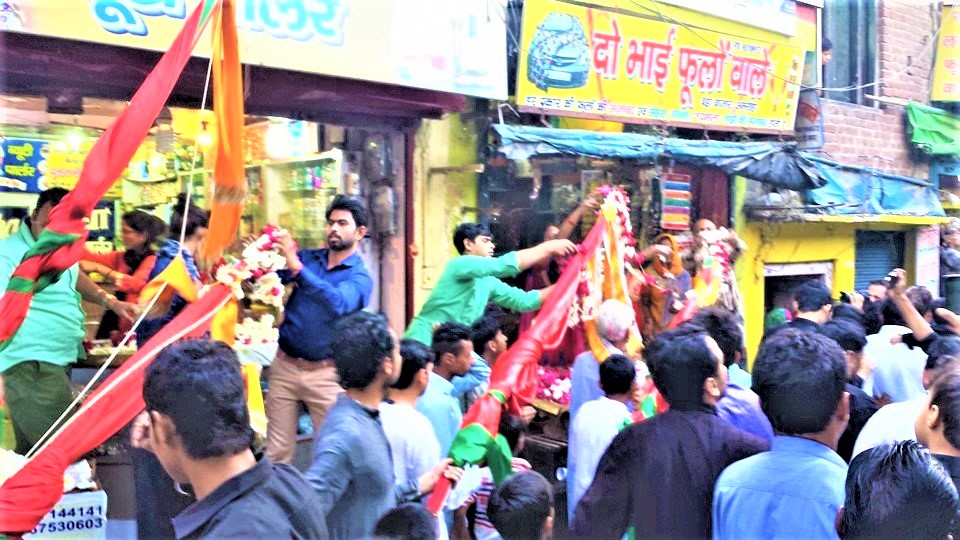
On the sight of the Moharram moon, the whole city echoes with the sound of laments and dirges. In anticipation of Muharram’s gatherings, the Imam Baras are refurbished and painted, their teak wood and metal work polished, the walls and floors scoured, and finally they are adorned with expensive chandeliers, many of them dating back to the 18th and 19th centuries. Each Imam Barah hosts the guests of Imam Husain (AS) and so it made ready for this honor which is the pride and joy of both Shia and Sunni families.
As Imam Hussain’s message took root in Amroha, Karbala became central to the entire populace of the city, Muslims, and non-Muslims alike. Centuries passed, each mohalla developed its own subculture which included the mourning process. It is quite incredible to think so in this time an age, but a mohalla of 9-10 households would have its own style of reading marsiyas, its own matam nohas, its own way of participation, and a myriad of traditions down to which elder sits where in a majlis and which family’s which members reads what and what they distribute as niaz.
However, even within Amroha a procession developed which is so unique its participants were almost exclusively from the mohallas of Katkoi, Bara Darbar, and Mandi. The residents of these three mohallas are essentially part of one family or clan which spread across a wide area as it grew in size. The family members would take out a procession from Bara Darbar to Katkoi, some 2 km apart and passing a busy part of the city.
Given the syncritic nature of Karbala and its ownership by Amroha’s religious communities, some two centuries ago a Hindu woman joined the procession to beg Imam Hussain (AS) for a son. The woman prayed that if she was blessed with a son, she would dedicate a jori (pair) of alam to Imam Hussain (AS) that would honour him as the Prince of Paradise and proclaim his blessings for all eternity.
Even today, the procession on 7th Muharram proceeds from the Qatra mohalla which is populated by Hindus who also receive the procession when it returns. Mourners in the procession are offered sherbet, tea, and water from metal vessels which have been borrowed from a Hindu temple and have Hindu symbols including inscriptions of “Om” and the Trishul (trident) of Lord Shiva.
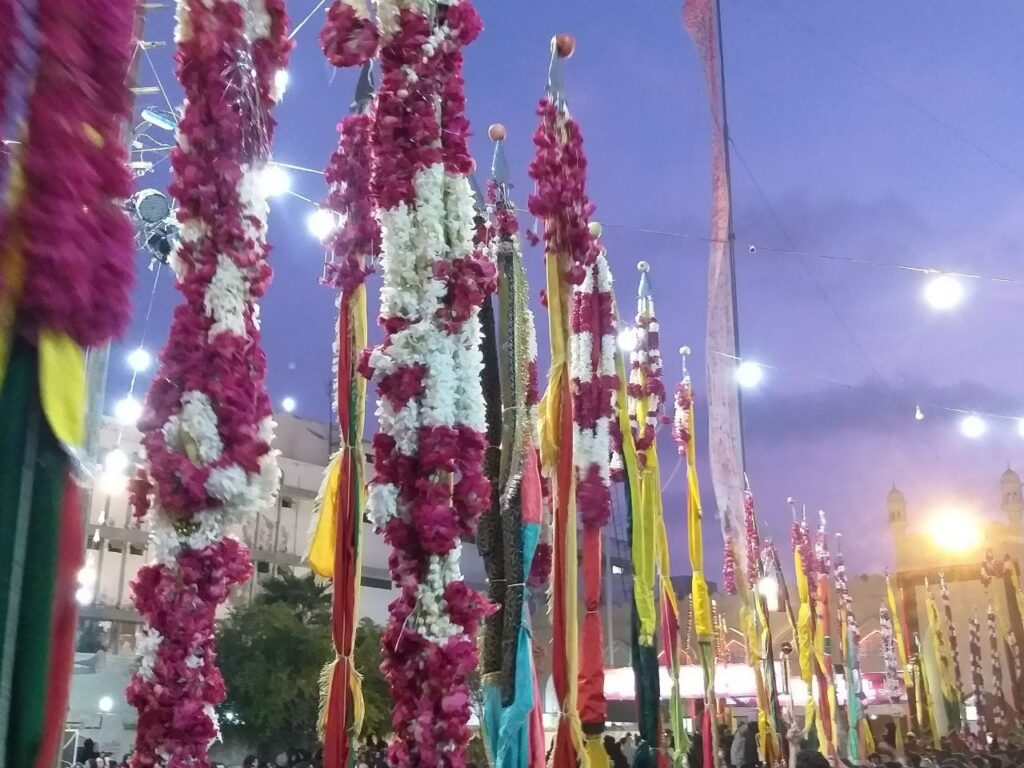
The woman’s prayer was answered, and she made two alam herself which she dedicated to the procession. However, these were different from the austere ones that fly a bloody standard or display the weapons of the battle of Karbala. They represent the tragic massacre that took place at Karbala but the her alam were blessed offerings celebrating the Imam as the giver of life. For them the woman chose the finest materials she could find: brightly coloured silks and a saffron cloth blessed by the pandit from Amroha’s largest Hindu temple, saffron being the colour directly associated with Hinduism.
Seeing the woman blessed so, other mourners, Hindu and Muslim, started making similar prayers and when their prayers were answered, they too made alams of a similar fashion. Thus was born the Nishaan (Birthmark/Symbols) Juloos. Eventually all the alam in the procession from Bara Darbar to Kotkoi followed this path and the alam are all made of bright silks in shared of red, green, pink, blue, and yellow. The procession is unique in the sense that while mourning for Imam Hussain (AS), it also celebrates him and his manifest victory. Hence the colorful alam and the manaqib (paeans) which are read along the way to recount events from Imam Husain’s life that glorify him and his followers. One charmingly remembers an incident in which he played with a fawn in his grandfather’s lap and another recalls his prayers of gratitude for his followers.
In Amroha the mourners continue to bear a saffron cloth blessed by a Hindu pandit and stop at the mandir to receive his blessings. The Hindu community stands along both sides to decorate the alam with flowers, kiss them to receive the blessings, and shower the procession with rose petals till the road is inches deep with fragrant blossoms.
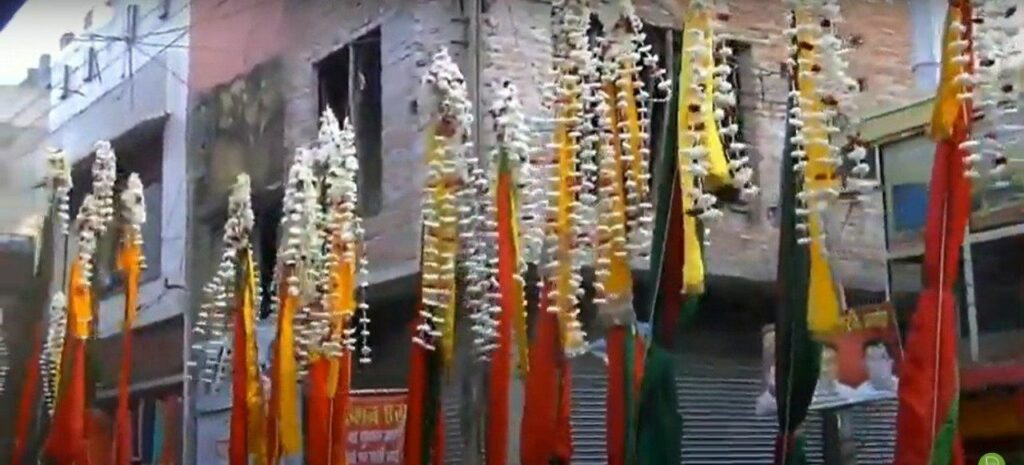
Post-Partition, many of the residents of Katkoi, Mandi, and Bara Darbar came to Karachi and settled closely together as family members tend to. They carried on the tradition of Nishaan in Karachi which commences on evening of 9th Muharram from Rizvia Society. The procession starts at the same time as its counterpart in Amroha and the route is approximately the same length. It is again remarkable that the early immigrants did all this by design and planed the procession as an exact replica of the one in their homeland.
Around each jori (pair) the relatives of the person who prayed for the blessings of a child gather and in the light of handheld lamps and electrical lights read eulogies and paeans for Imam Hussain (AS). The procession moves gracefully, each household reciting a different chapter of Imam Husain (AS) life. In memory of the first Nishaan they are still adorned with a saffron cloth though sadly, in Karachi it is not blessed by a Hindu pandit.
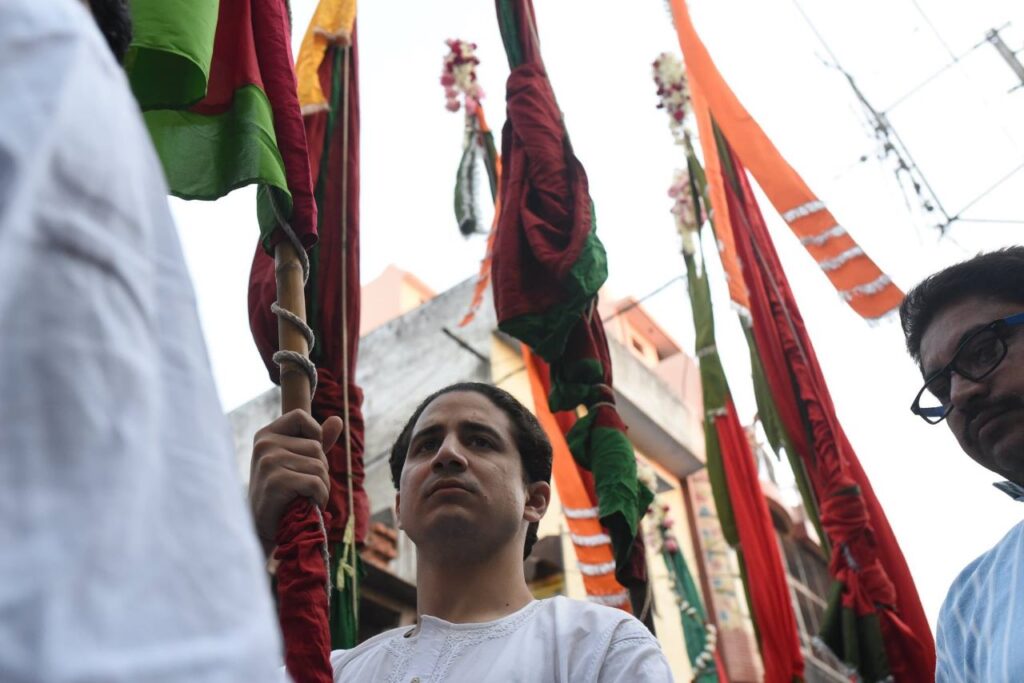
In the 1980s and 1990s, the second migration of Amrohvis in Pakistan started and most made their way to the United States. Eventually the Nishaan found another home in Houston, Texas where the largest group of those from mohalla Katkoi, Mandi and Bara Darbar outside of the subcontinent now reside and organize the Nishaan juloos in the city.
It is quite incredible how the prayers of a Hindu woman created a tradition followed by followers of Imam Husain in Amroha, Karachi, and Houston. The fragrant and brightly colored standards are borne aloft, reaching towards the sky, and taking the gratitude and prayers of mourners to celestial heavens. Truly, the Nishaan are an example of a subculture within a subculture and living embodiment of the syncretism, inclusiveness, and universality of Karbala that transcends faith and religion, an all-encompassing syncretism whose roots can be traced back to the Day of Ashura itself.
According to traditions, Zain-ul-Abedin’s mother, Bibi Shahar Bano, was the daughter of the last Sasanian king, Yazdegerd III (632-51), who lost his empire after defeats in the battle of Qadisiyyah in 636/637 which was followed by the sack of the Sasanian winter capital at Ctesiphon on the Tigris. The Battle of Nahāvand in 642 completed the Sassanids' vanquishment and as the Sassanid empire fell, the royal family of Persia disbursed, some were brought to Medina while others made their way to India. Imam Husain married Princess Shahar Bano while her sister Princess Mehr Bano married a Hindu king in India.
Zain-ul-Abedin told his family in India about their mission and sensing their fatal battle, his Hindu uncle set off with his warriors to help Imam Husain at Karbala. He arrived too late to save him but his progeny, the Hussaini Brahmins mourn their failure to help the Imam at his hour of need and commemorate Karbala to this day and practice matam and other mourning rites associated with the remembrances of the tragedy of Karbala. The family of Indian actor Sunil Dutt are part of this branch of Husaini Brahmins.
The Prophet (PBUH)’s family was persecuted by the Umayyads and Abbasids even after Karbala and some of them did come to India including Hazrat Abdullah Shah Ghazi, the grandson of Imam Hasan (AS) and patron saint of Karachi. India has been a fecund land for spirituality since centuries and the Ahle Bait and the message of Karbala received a warm reception in the land of Indus, Ganga, and Jumna.
India soon became a major destination for Imam Hussain (AS)’s followers. The various Sufi orders traced their knowledge and tradition to Imam Ali (AS) and spread the lessons of Karbala. Prominent among these are the Suhrawardy and Chishti orders and their famous Sufi saints include Bahauddin Zakariya, Shah Rukan-e-Alam, Nizamuddin Auliya, Salim Chishti, and others. Due to Sufism’s role in the spread of Islam in the subcontinent and Sufism’s own deep connection with Karbala, pre-partition India had the highest population of mourners of Imam Hussain (AS). The kingdoms of Awadh and Hyderabad were ruled by Shia nawabs and became a key center of Shia tradition in India but also helping the building and maintenance of the tombs of Imam Ali, Imam Hussain, and other members of the Prophet’s (PBUH) family.
After the fall of the kingdom of Awadh, other cities in the newly formed United Provinces (now Uttar Pradesh) continued their traditions of mourning which have only deepened with time. Among the centers of mourning in Uttar Pradesh is Amroha which developed its distinct traditions, sharing some with the ones in nearby Lucknow but also carrying on what are very much its own.
Amroha is now a designated city and the capital of its district but even though for most of history it was a qasbah i.e., bigger than a village but smaller than a city, it has 52 Imam Baras, one for each mohalla. This number does not include the Imam Baras which are exclusively for females. The city has produced famous marsiya poets and its azaadari (mourning) is well known for its uniqueness.

On the sight of the Moharram moon, the whole city echoes with the sound of laments and dirges. In anticipation of Muharram’s gatherings, the Imam Baras are refurbished and painted, their teak wood and metal work polished, the walls and floors scoured, and finally they are adorned with expensive chandeliers, many of them dating back to the 18th and 19th centuries. Each Imam Barah hosts the guests of Imam Husain (AS) and so it made ready for this honor which is the pride and joy of both Shia and Sunni families.
As Imam Hussain’s message took root in Amroha, Karbala became central to the entire populace of the city, Muslims, and non-Muslims alike. Centuries passed, each mohalla developed its own subculture which included the mourning process. It is quite incredible to think so in this time an age, but a mohalla of 9-10 households would have its own style of reading marsiyas, its own matam nohas, its own way of participation, and a myriad of traditions down to which elder sits where in a majlis and which family’s which members reads what and what they distribute as niaz.
Pandit Chander Prakash said, “Lord Krishna in Bhagwat Gita’s chapter 12 has mentioned 14 qualities to be found in man for him to become the ‘Apostle of God’. The accumulation of all the 14 qualities are only in Imam Husain, as described by Lord Krishna in Bhagwat Gita."
However, even within Amroha a procession developed which is so unique its participants were almost exclusively from the mohallas of Katkoi, Bara Darbar, and Mandi. The residents of these three mohallas are essentially part of one family or clan which spread across a wide area as it grew in size. The family members would take out a procession from Bara Darbar to Katkoi, some 2 km apart and passing a busy part of the city.
Given the syncritic nature of Karbala and its ownership by Amroha’s religious communities, some two centuries ago a Hindu woman joined the procession to beg Imam Hussain (AS) for a son. The woman prayed that if she was blessed with a son, she would dedicate a jori (pair) of alam to Imam Hussain (AS) that would honour him as the Prince of Paradise and proclaim his blessings for all eternity.
The Hindus of Amroha considered the Imam as a “Holy Man”, a sadhu, a saint, and some even calling him an avatar of Lord Vishnu, the sustainer. This is not surprising as Pandit Chander Prakash said, “Lord Krishna in Bhagwat Gita's chapter 12 has mentioned 14 qualities to be found in man for him to become the ‘Apostle of God'. The accumulation of all the 14 qualities are only in Imam Husain, as described by Lord Krishna in Bhagwat Gita.”
Even today, the procession on 7th Muharram proceeds from the Qatra mohalla which is populated by Hindus who also receive the procession when it returns. Mourners in the procession are offered sherbet, tea, and water from metal vessels which have been borrowed from a Hindu temple and have Hindu symbols including inscriptions of “Om” and the Trishul (trident) of Lord Shiva.

The woman’s prayer was answered, and she made two alam herself which she dedicated to the procession. However, these were different from the austere ones that fly a bloody standard or display the weapons of the battle of Karbala. They represent the tragic massacre that took place at Karbala but the her alam were blessed offerings celebrating the Imam as the giver of life. For them the woman chose the finest materials she could find: brightly coloured silks and a saffron cloth blessed by the pandit from Amroha’s largest Hindu temple, saffron being the colour directly associated with Hinduism.
Seeing the woman blessed so, other mourners, Hindu and Muslim, started making similar prayers and when their prayers were answered, they too made alams of a similar fashion. Thus was born the Nishaan (Birthmark/Symbols) Juloos. Eventually all the alam in the procession from Bara Darbar to Kotkoi followed this path and the alam are all made of bright silks in shared of red, green, pink, blue, and yellow. The procession is unique in the sense that while mourning for Imam Hussain (AS), it also celebrates him and his manifest victory. Hence the colorful alam and the manaqib (paeans) which are read along the way to recount events from Imam Husain’s life that glorify him and his followers. One charmingly remembers an incident in which he played with a fawn in his grandfather’s lap and another recalls his prayers of gratitude for his followers.
In Amroha the mourners continue to bear a saffron cloth blessed by a Hindu pandit and stop at the mandir to receive his blessings. The Hindu community stands along both sides to decorate the alam with flowers, kiss them to receive the blessings, and shower the procession with rose petals till the road is inches deep with fragrant blossoms.

Post-Partition, many of the residents of Katkoi, Mandi, and Bara Darbar came to Karachi and settled closely together as family members tend to. They carried on the tradition of Nishaan in Karachi which commences on evening of 9th Muharram from Rizvia Society. The procession starts at the same time as its counterpart in Amroha and the route is approximately the same length. It is again remarkable that the early immigrants did all this by design and planed the procession as an exact replica of the one in their homeland.
Around each jori (pair) the relatives of the person who prayed for the blessings of a child gather and in the light of handheld lamps and electrical lights read eulogies and paeans for Imam Hussain (AS). The procession moves gracefully, each household reciting a different chapter of Imam Husain (AS) life. In memory of the first Nishaan they are still adorned with a saffron cloth though sadly, in Karachi it is not blessed by a Hindu pandit.

In the 1980s and 1990s, the second migration of Amrohvis in Pakistan started and most made their way to the United States. Eventually the Nishaan found another home in Houston, Texas where the largest group of those from mohalla Katkoi, Mandi and Bara Darbar outside of the subcontinent now reside and organize the Nishaan juloos in the city.
It is quite incredible how the prayers of a Hindu woman created a tradition followed by followers of Imam Husain in Amroha, Karachi, and Houston. The fragrant and brightly colored standards are borne aloft, reaching towards the sky, and taking the gratitude and prayers of mourners to celestial heavens. Truly, the Nishaan are an example of a subculture within a subculture and living embodiment of the syncretism, inclusiveness, and universality of Karbala that transcends faith and religion, an all-encompassing syncretism whose roots can be traced back to the Day of Ashura itself.

